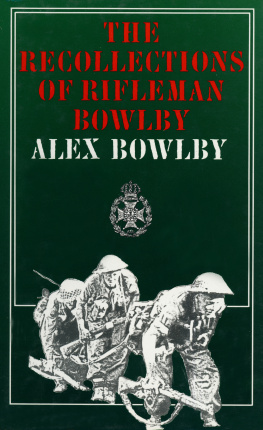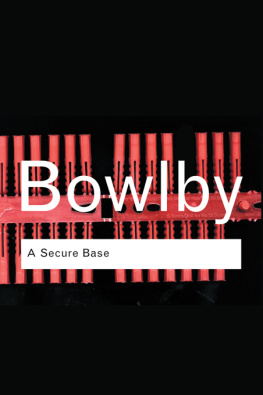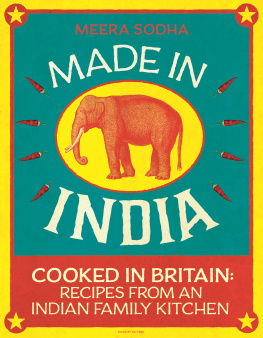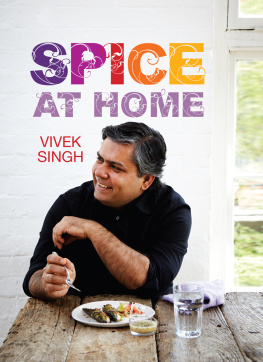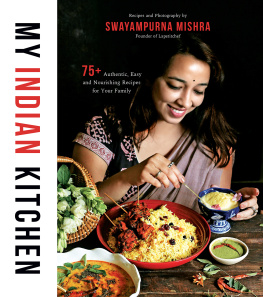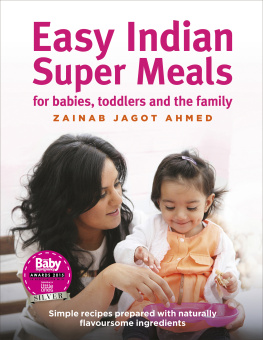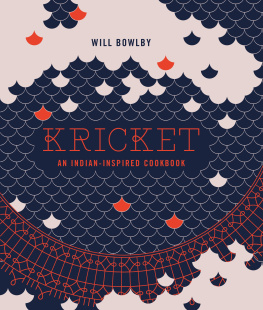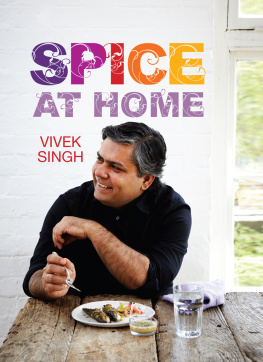I would like to dedicate this book to my grandmother, Margaret Bell, who inspired me from an early age with her brilliant cooking. She would have loved Kricket, so this one is for you, Danny x
Because I am French, people think I may have little time for other types of cuisines, but I am excited by all kinds of cooking, flavours and ingredients.
I was surprised when I visited India, a few years ago, at just how much I enjoyed the variety of food and dishes. Id never tasted curries like these before and I didnt taste that kind of Indian cooking again, until I visited Wills restaurant, Kricket, in London.
Will served me a beautifully spiced, first class vindaloo that transported me back to India it was delicious. His ability to recognise the importance of balance in food and to let the ingredients do the work, is what makes the food at Kricket so special. Strong flavours, like those typically associated with Indian cooking, require restraint and judgement, and those are the qualities that Will displays in his cooking. His focus is on the quality of the produce itself and everything else is designed to enhance that ingredients flavour and appeal.
I never expected a young Englishman to show such mastery of Indian cuisine. I havent asked him to tutor me, but I am hoping to learn a thing or two from this book.
PIERRE KOFFMANN
As far back as I can remember, I have always been passionate about food. My earliest memory is of my mothers chicken in a pot, a herby, unctuous dish that kick-started my five-year-old taste buds and began my love affair with all things to do with food. My maternal grandmother was a huge influence on me; she had lived in post-war East Africa for over a quarter of a century and was a terrific cook. She had a number of very close Indian and Goan friends and had learned skills from them over the years; her curry lunches (for up to 60 people) were legendary, and introduced me at a very early age to the delicate layering and spicing of meat and fish.
So I started young, and by the age of ten I was hooked; Jamie Oliver had just come on the scene and he was so inspiring. His can-do approach to food was so cool and made me think: yes, thats what I want to do. I want to be a chef!
While still at school, I set up my own one-man catering company, Will2Cook, providing food for private dinner parties and events, which helped fund my gap year and my time at university. After three wonderful years at Newcastle University, I joined renowned chef Rowley Leigh at his flagship restaurant Le Caf Anglais in London. He lived up to his promise to throw me in at the deep end. I started on simple dishes, such as creamed spinach, and over the next two years, worked my way up through all the disciplines, until I was eventually made chef de partie.
I was then approached by a colleague working in India. The owners of Khyber, the oldest and most respected Indian restaurant in Mumbai, were looking for a young English chef to work on the concept of a modern European restaurant they were planning to open in the heart of the city. Following a couple of chaotic trials in London (which gave me a good indication of what was to follow!), I was offered a job in a country I had never visited and knew even less about. On a cold, rainy day in October 2012 I found myself, at the age of 24 with only one business contact, at Heathrow airport boarding a flight to Mumbai to face the biggest challenge of my life so far.
For nearly two years I lived alone in a flat in south Mumbai. I was responsible for a kitchen staff of 20, many of whom spoke no English. The dishes I was asked to create were based on the idea of European recipes that would appeal to the Indian palate. I wasnt to know then that the Indian palate is a many-layered and complicated concept, influenced by religion, ethnicity and cultural preferences. We worked extremely hard as a team, often in challenging and difficult circumstances, and it paid off when we won The Times of India award for the Best New European Restaurant. I spent the next few months on the menus at Khyber and, in my spare time, had Indian cooking lessons with the private chef of a famous Mumbai art dealer in his kitchen, who suggested I might one day combine the different techniques I had learned to create a fusion restaurant.
It was here that my fledgling business plan began to take shape. I was so inspired and excited by the different regional cuisines, and started to think about how I could apply my new knowledge that to the fast-food craze taking place in the UK, where I sensed there was a gap in the market between the traditional high street curry house and the high-end expensive Indian restaurants. My research took me to the street stalls of Mumbai where I discovered new favourites: masala dosa a wafer-thin, crispy Indian pancake filled with potato and spices; and another intensely marinated snack, bright red from its masala sauce. Whats this? I asked. Goats nipple, the vendor told me. Suddenly all sorts of culinary possibilities began to show themselves.
I handed in my notice and embarked on a three-month road trip to see as much of India as I could in my search for the perfect street food. In Goa, I ate super-fresh oysters with coconut cream and chilli in a tiny roof-top restaurant 10 minutes from Arambol beach. In the old city of Delhi, I discovered butter chicken and spicy little kebabs. In Ladakh, where the dusty desert runs into snow-capped mountains of astonishing beauty, the Nepalese momos (small dumplings stuffed with spiced vegetables) were an unexpected delight.
Family connections landed me an invitation to a smart mansion in Lucknow where I downed a glass of a suspiciously green smoothie before being led into the old towns warren of alleyways to a street cart serving sensational shami kebabs: a snack originally created for a toothless Nawab, and made by massaging goat meat and then grinding it down to a paste. Travelling on by train, I ate simple but delicious dal curries, served with rice, chapati and pickles in airline-style trays, made with a pride that would put many restaurants, back home, to shame. The highlights in Calcutta were kathi rolls: chicken and egg wrapped in buttery paratha; and misti doi, a sumptuous pudding of yogurt served with cardamom, rose and pistachio (see my version ).
With time and money running out, I returned to England with a head full of ideas and a plan of action: I wanted to explore the idea of taking traditional recipes from the different regions and giving them a twist. Using only the very best of British seasonal ingredients (something I found lacking in India where so much of the highest-quality produce, especially meat and fish, is destined for the export market), I would produce delicious, affordable food showcasing the diversity and intricacy of the recipes to create a contemporary Indian cuisine, presenting it in the new concept of a limited menu offering small plates of food to share. It was an idea that needed working on, and rather than pretending to know how to master the cuisine, I joined top chef Vivek Singh in his flagship restaurant in the City of London, and built on my fledgling knowledge of how to cook with spices. A year later I left, and Kricket was born.



